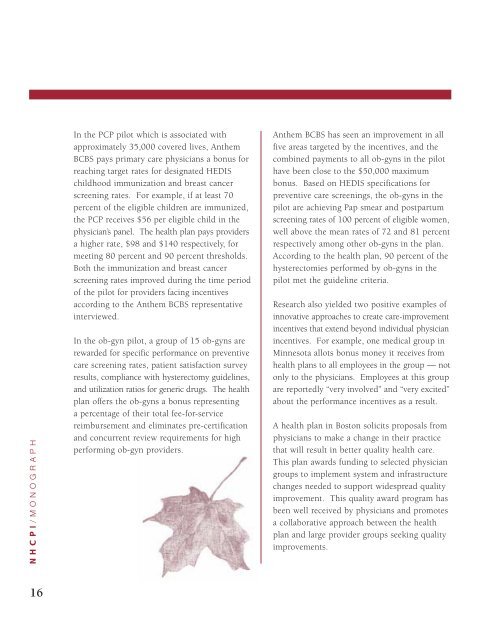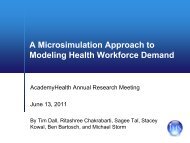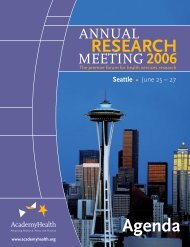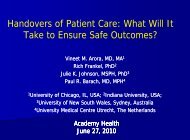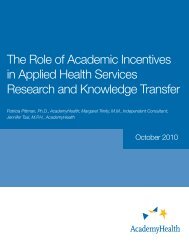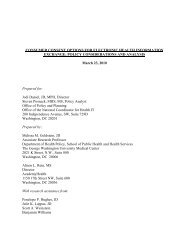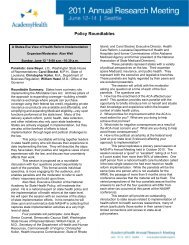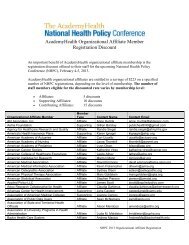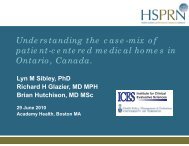The Growing Case for Using Physician Incentives to - AcademyHealth
The Growing Case for Using Physician Incentives to - AcademyHealth
The Growing Case for Using Physician Incentives to - AcademyHealth
You also want an ePaper? Increase the reach of your titles
YUMPU automatically turns print PDFs into web optimized ePapers that Google loves.
NHCPI/MONOGRAPH<br />
In the PCP pilot which is associated with<br />
approximately 35,000 covered lives, Anthem<br />
BCBS pays primary care physicians a bonus <strong>for</strong><br />
reaching target rates <strong>for</strong> designated HEDIS<br />
childhood immunization and breast cancer<br />
screening rates. For example, if at least 70<br />
percent of the eligible children are immunized,<br />
the PCP receives $56 per eligible child in the<br />
physician’s panel. <strong>The</strong> health plan pays providers<br />
a higher rate, $98 and $140 respectively, <strong>for</strong><br />
meeting 80 percent and 90 percent thresholds.<br />
Both the immunization and breast cancer<br />
screening rates improved during the time period<br />
of the pilot <strong>for</strong> providers facing incentives<br />
according <strong>to</strong> the Anthem BCBS representative<br />
interviewed.<br />
In the ob-gyn pilot, a group of 15 ob-gyns are<br />
rewarded <strong>for</strong> specific per<strong>for</strong>mance on preventive<br />
care screening rates, patient satisfaction survey<br />
results, compliance with hysterec<strong>to</strong>my guidelines,<br />
and utilization ratios <strong>for</strong> generic drugs. <strong>The</strong> health<br />
plan offers the ob-gyns a bonus representing<br />
a percentage of their <strong>to</strong>tal fee-<strong>for</strong>-service<br />
reimbursement and eliminates pre-certification<br />
and concurrent review requirements <strong>for</strong> high<br />
per<strong>for</strong>ming ob-gyn providers.<br />
Anthem BCBS has seen an improvement in all<br />
five areas targeted by the incentives, and the<br />
combined payments <strong>to</strong> all ob-gyns in the pilot<br />
have been close <strong>to</strong> the $50,000 maximum<br />
bonus. Based on HEDIS specifications <strong>for</strong><br />
preventive care screenings, the ob-gyns in the<br />
pilot are achieving Pap smear and postpartum<br />
screening rates of 100 percent of eligible women,<br />
well above the mean rates of 72 and 81 percent<br />
respectively among other ob-gyns in the plan.<br />
According <strong>to</strong> the health plan, 90 percent of the<br />
hysterec<strong>to</strong>mies per<strong>for</strong>med by ob-gyns in the<br />
pilot met the guideline criteria.<br />
Research also yielded two positive examples of<br />
innovative approaches <strong>to</strong> create care-improvement<br />
incentives that extend beyond individual physician<br />
incentives. For example, one medical group in<br />
Minnesota allots bonus money it receives from<br />
health plans <strong>to</strong> all employees in the group — not<br />
only <strong>to</strong> the physicians. Employees at this group<br />
are reportedly “very involved” and “very excited”<br />
about the per<strong>for</strong>mance incentives as a result.<br />
A health plan in Bos<strong>to</strong>n solicits proposals from<br />
physicians <strong>to</strong> make a change in their practice<br />
that will result in better quality health care.<br />
This plan awards funding <strong>to</strong> selected physician<br />
groups <strong>to</strong> implement system and infrastructure<br />
changes needed <strong>to</strong> support widespread quality<br />
improvement. This quality award program has<br />
been well received by physicians and promotes<br />
a collaborative approach between the health<br />
plan and large provider groups seeking quality<br />
improvements.<br />
16


